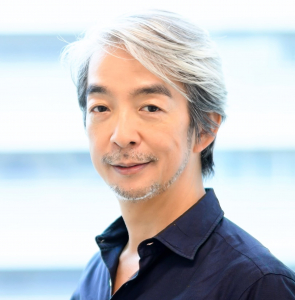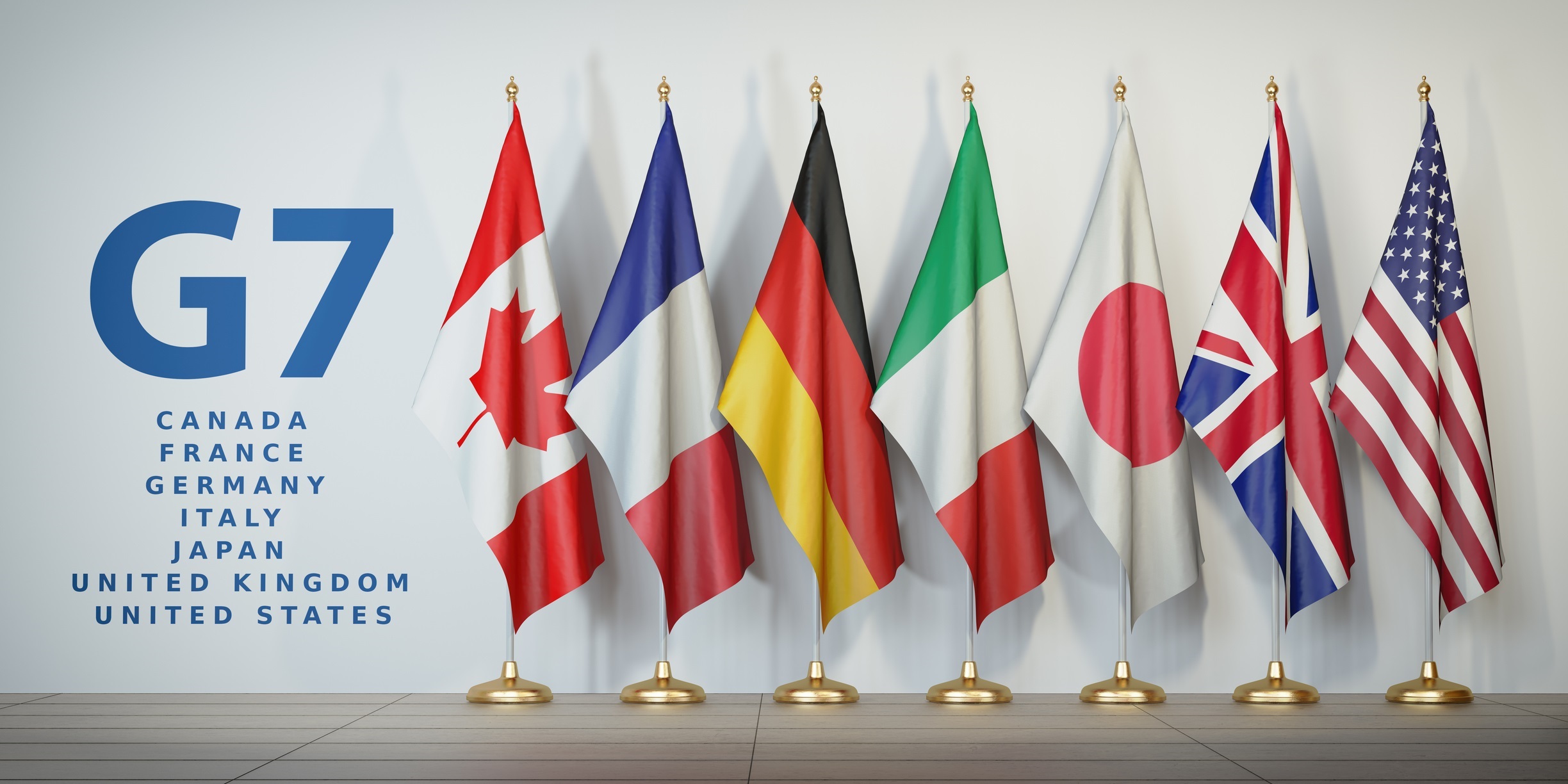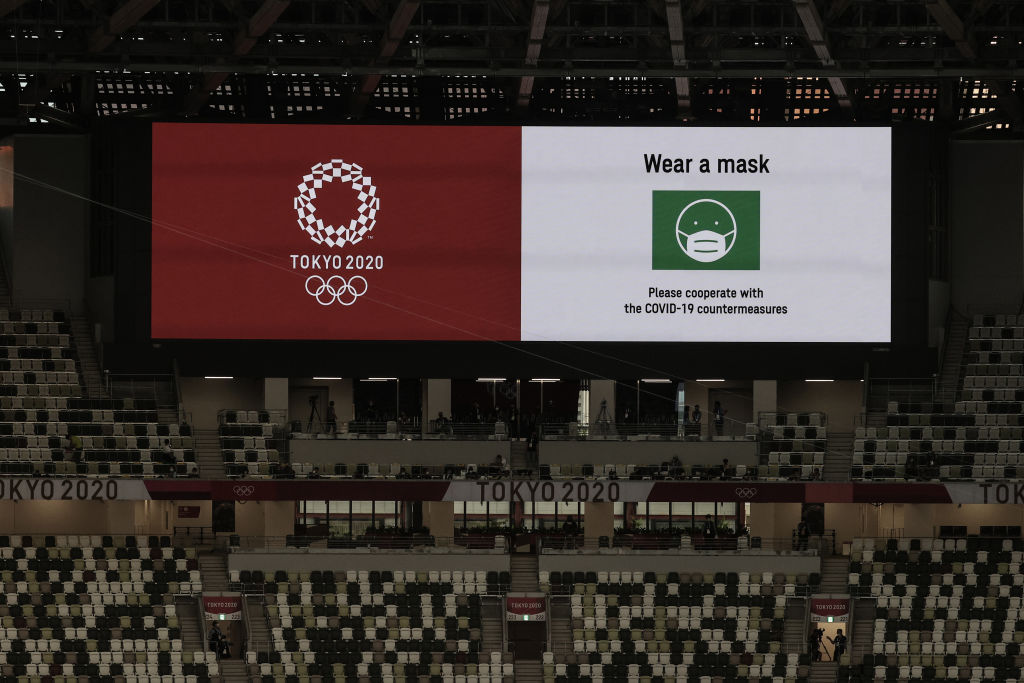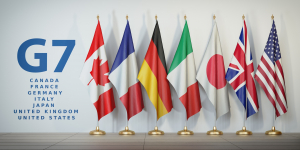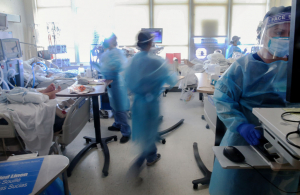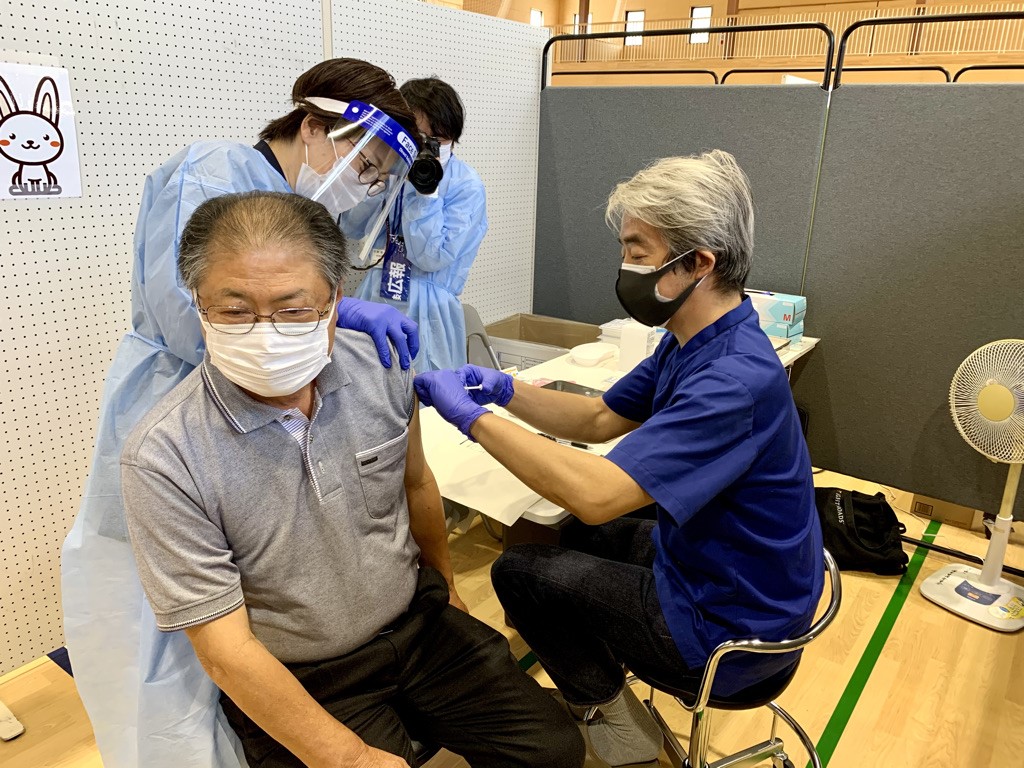
Japan Needs to Rapidly Implement Booster Shots and Expand Tests
December 6, 2021
R-2021-016
Japan’s response to COVID-19 has primarily been to rely on people’s voluntary efforts to block transmission routes, with tests and vaccinations being given secondary importance. As vaccine coverage has increased worldwide, making COVID-19 a controllable disease, countermeasures have reached a major turning point. Japan should prepare for a sixth wave with the spread of the new Omicron variant this winter and develop a roadmap incorporating science-based approaches to managing COVID while promoting the revival of social and economic activities.
Pre-Existing Health System Defects
The fifth wave of COVID-19 in Japan coincided with the Tokyo 2020 Olympic and Paralympic Games, with the number of severely ill patients exceeding the number of available beds in Tokyo and other cities. News of people who died without being able to receive sufficient treatment, some quite suddenly while convalescing at home, shocked many people. There were more than 250 such deaths,[1] exposing structural weaknesses in Japan’s supposedly world-class health system. Some have called these shocking events a sign that Japan’s universal health coverage—premised on enabling anyone, anytime, anywhere to receive necessary medical care at an affordable cost—had collapsed.
Apologists note that the number of COVID-19 cases exceeded expectations and that the situation could not be prevented, given the rapid expansion of the more contagious Delta variant.[2] But the media questioned such assertions, noting that medical care in Japan is excellent, cases are fewer than in Europe and the United States, and the number of beds per capita is far greater than in these countries. Opinions were also expressed in the media asking why doctors and nurses could not do a better job.
Japan’s experience, though, points to a fundamental structural failure in the country’s health system. The problems have existed for many years but have only now been exposed by the pandemic. The large number of beds is a historical vestige of having secured many beds for psychiatric and nursing care. Many beds designed for elderly care should have been transferred to facilities for long-term care. Most countries now care for these people in the community instead of keeping them in hospitals; but in Japan, hospital-based care is still dominant, and the number of available beds thus seems to be large on paper.
Another weakness of healthcare in Japan is the proliferation of small to medium-sized private “general” hospitals.[3] Doctors are assigned in each department of every hospital, but the quality and utilization status vary substantially across hospitals, contributing to an inefficient and distorted health system. Young doctors at university hospitals are most affected by this distortion; they work full-time on weekdays at university hospitals but are unpaid or paid minimally, so to make a living they have to work part-time at a private hospital at night or on weekends, when there are staff shortages.[4]
Such distortions can be reduced by clarifying and consolidating the functions of specific hospitals in each region. But this, while possible in theory, is not easy to implement in practice.[3] The “fragmented and poorly differentiated” functions of hospitals in Japan not only lead to a poor working environment for doctors but also make it difficult to respond to COVID-19 cases, which create sudden surges in medical demand. In particular, ventilator management for COVID-19 patients is a burden that is too heavy for a single doctor to handle, and the presence of severely ill patients can overwhelm doctors, nurses, and other staff.
Exacerbating the weaknesses of Japan’s health system is the narrowness of doctors’ area of expertise. The majority of doctors in Japanese hospitals are specialists, and the proportion of general practitioners is lower than in other countries.[3] It would be better for general practitioners, general internists, and intensive care doctors to deal with new infectious diseases like COVID-19 than organ-specific specialists. The composition of doctors will thus need to be corrected over the medium to long term. At present, doctors in general internal medicine, who are best suited to deal with COVID patients, are widely dispersed in many hospitals, and not enough are being deployed at key hospitals.
In the United Kingdom, which experienced a large number of COVID-19 cases and deaths, the National Health System (NHS) was able to prevent the collapse of medical care because it was able to quickly prepare an emergency medical supply system. In about just one week, each NHS hospital was transformed to support COVID-19 patients. Each acute care hospital secured hundreds of beds exclusively for such patients and increased the number of ICU beds. Temporary hospitals exclusively for moderate cases were also established nationwide.
This was possible because more than 90% of UK hospitals are public, enabling the government to exert control at a time of national crisis. In Japan, by contrast, the majority of hospitals are private, and because of the “fragmented and poorly differentiated” provision of services, there are many legal hurdles in responding to emergencies. For example, consolidating staff to treat COVID-19 patients at a specific public hospital and designating such hospitals specializing in COVID-19 treatment will require relocating doctors and other staff in each region from a macro perspective. But the fixed structure of Japanese hospital functions makes it difficult to efficiently allocate such medical resources.
The Scourge of Vested Interests
These issues have been pointed out in the past. In July 2020, the ruling Liberal Democratic Party’s Governance Reform Headquarters, headed by Yasuhisa Shiozaki, proposed a sweeping revision of the antiquated Infectious Diseases Law, enacted more than 120 years ago. The working group proposed that the Minister of Health, Labor, and Welfare, along with prefectural governors, be given the authority to request and order the hospitalization of critically ill patients, build a system to coordinate a wide-area response, and actively disclose information on the hospitalization of critically ill patients.[5] They also called for the integration of information systems for public health and medical care.
The proposal points out that the legal divide between public health and medical care was a fundamental obstacle in Japan’s pandemic response, saying “the major reason for the slow initial pace of PCR testing was the ill-defined respective roles of national and prefectural governments, private medical institutions, private testing institutions, etc., under the Infectious Diseases Law. PCR tests were thus held up by hierarchical rigidities in the relationship between public health and clinical medical care and the adverse impact of administrative compartmentalization.”[5]
While the proposed revisions to the Infectious Diseases Law challenged the existing public health system centered on the National Institute of Infectious Disease (NIID) and health centers, they was watered down, I have learned, by officials in the Ministry of Health, Labor, and Welfare and NIID, who were disinclined to having their authority weakened. In a recent article, Shiozaki noted with considerable frustration, “The bill that was passed by the LDP political council was largely ignored by officials in the Ministry of Health, Labor, and Welfare.”[6] Since the Establishment Act of the National Hospital Organization and the Japan Community Health Care Organization (JCHO) states that “during times of a serious public health emergency, the Minister of Health, Labor, and Welfare can request the Organization to carry out any necessary work,” it should therefore have been possible to secure enough beds without amending the Infectious Diseases Law.
Nevertheless, one and a half years after the pandemic began, the number of beds for severe to moderate COVID-19 patients in public JCHO hospitals was extremely small; even during the devastating fifth wave from July to September 2021, only 5% of total beds were set aside for COVID patients, and only about half of those were actually used.[7] This clearly indicates that patients were not being treated efficiently at acute care hospitals but in a fragmented manner at many small- to medium-sized private hospitals. While COVID-19 is a health crisis of unprecedented scale, the breakdown in Japan’s medical response may have exposed an even bigger administrative crisis. I am reminded of the comments made by Professor Kiyoshi Kurokawa, chairman of the National Diet’s Fukushima nuclear accident investigation committee, who pointed out, “Management-track employees seeking to climb up the corporate or bureaucratic ladder are preoccupied with following precedent and protecting the interests of their organizations, even more so than protecting people’s lives. They were no doubt familiar with global, nuclear safety trends, but they turned their eyes away and postponed the implementation of troublesome safety measures.”[8]
Can Vaccine Roll-Out Make COVID Manageable?
One characteristic of COVID-19 is its explosive infectiousness. As the number of infected people increases, so does the number of hospitalizations and deaths. And since airborne infection by asymptomatic people is the main route of transmission, it is extremely challenging to control using so-called “cluster control measures” that test and trace only symptomatic, infected persons and their close contacts. Before the development of vaccines, the only way to prevent medical collapse from the exponential spread of infection was to abruptly disrupt the route of transmission (through lockdowns or state of emergency declarations). And the so-called “zero COVID” elimination strategy to keep the number of infected people as low as possible was the most rational strategy.[9]
The approved COVID-19 vaccines are excellent, highly effective, and safe, and they have been shown to significantly reduce the risk of hospitalization and death. In other words, even when there are many COVID cases, pressure on medical systems can be mitigated if people are vaccinated. Furthermore, if and when an oral antiviral drug is approved, the disease can be prevented from becoming more severe, so lockdowns will theoretically no longer be necessary. With the worldwide roll-out of vaccines, measures against COVID-19 have reached a major turning point.[10]
There are three basic approaches to preventing transmission: (1) disrupting the route of infection, such as by mask wearing, ventilation, hand washing, and social distancing; (2) identifying and isolating the source of infection (early detection by expanding testing); and (3) acquiring immunity by promoting vaccination. The architect of Japan’s cluster control measures was Tohoku University Professor Hitoshi Oshitani, who contended in a February 27, 2020, Nikkei article that, “A lockdown is a nineteenth-century measure. There are ways to control the spread of the virus by discouraging certain behaviors”[11] He proposed a “Japanese model” consisting primarily of disrupting the route of transmission through people’s voluntary efforts. The expansion of tests and the roll-out of vaccination were thus delayed, and this mindset largely continues to inform government policy to this day.
But this has resulted in the atrophying of Japan’s society and economy due to repeated cycles of expanded infections and state-of-emergency declarations. The hospitality industry, notably restaurants and bars, were unreasonably singled out for “cluster control measures” despite the limited data available. The fourth state of emergency, moreover, during the fifth wave had almost no effect on suppressing the flow of people due to such factors as COVID fatigue, summer vacation, and the hosting of the Tokyo Games.
This prompted JCHO President Shigeru Omi, who chairs the Japanese government’s novel coronavirus infection control subcommittee, to declare that there may be a need to legislate a lockdown, given the very limited impact of state-of-emergency declarations.[12] Omi had long embraced Professor Oshitani’s notion of lockdowns being a nineteenth-century measure. This flip flop and the unscientific approach of experts at the Ministry of Health, Labor, and Welfare and the National Institute of Infectious Diseases seem to have alienated the public. As the fifth wave of infections wound down, even people on the street came to feel that the effect of suppressing human flow was extremely limited and that the decline in cases was primarily due to seasonal fluctuations, the effect of vaccines, and virus characteristics.[13]
In Japan, vaccination was significantly delayed due to a mix of historical factors (repeated vaccine litigations in the 1980s and 1990s have made policymakers extremely risk-averse) and structural factors (the Japanese vaccine industry consists mainly of small and medium-sized, heavily subsidized vaccine manufacturers).[14] Due to the inability of the Ministry of Health, Labor, and Welfare to respond quickly to emergencies, the Cabinet Office took over the vaccine roll-out under the political leadership of Prime Minister Yoshihide Suga and Vaccine Minister Taro Kono. The pace of vaccination quickened thereafter, aided by the absence of political resistance to vaccines in Japan and a scarcity mentality, particularly among the elderly. By mid-November 2021, Japan’s vaccine coverage was the highest among the G7 countries.[15]
Keeping the Momentum Going
Countries that are highly vaccinated are lifting behavioral restrictions, and priority is now shifting to the vaccination of children. Singapore boasts a vaccination rate of over 90% and had at one time adopted a “zero COVID” strategy. The country’s number of tests per population is more than 20 times that of Japan.[15] While reported cases have again been rising of late, this is not due to an increase in the flow of people but to an expansion of rapid antigen tests, with 98% of infected people being asymptomatic. Those testing positive need to self-isolate at home, but if they test negative 72 hours later, the requirement is lifted. Singapore is moving ahead with booster shots and expanding the number of tests. It has secured an adequate number of beds, and digital tracking is progressing.
Japan cannot match Singapore’s standards right away, and lifting all restrictions would be premature. This is because, considering the seasonality of the coronavirus, it is only a matter of time before the sixth wave arrives. Based on the findings of antibody tests in countries around the world, as well as in the Fukushima cities of Soma[16] and Minamisoma, the activities of neutralizing antibodies appear to decline three months after the second shot, especially among the elderly, suggesting that a booster dose is required. However, the government again appears to be prioritizing bureaucratic procedure over people’s safety, not allowing a third shot, in principle, until eight months have passed since the second dose. This runs counter to the recommendations in other countries calling for booster vaccines within six months of the second shot.
The recent low numbers of new daily cases in Japan have prompted calls for the lifting of all restrictions. But European countries are already experiencing another surge of cases, apparently due to seasonal factors and the waning effectiveness of vaccines. Another variant of concern, Omicron, has been spreading around the globe. Japan, too, should prepare for a sixth wave this winter by further strengthening vaccination, rapidly implementing booster shots, expanding the number of tests, and enhancing ventilation. We need to break away from a strategy centered on human flow control and instead advance a “precision public health” approach based on scientific evidence.
[1] NHK, “250 people die at home in August of COVID-19 infection, 8 times more than in July, Police Agency,” September 13, 2021, https://www3.nhk.or.jp/news/html/20210913/k10013257851000.html (accessed December 3, 2021).
[2] m3.com, “Demand for ‘more beds’ is an endless demand for finite medical care, says Director General of the Ministry of Health, Labor, and Welfare Masami Sakoi,” August 23, 2021, https://www.m3.com/news/iryoishin/955512 (accessed December 3, 2021).
[3] Ministry of Health, Labor, and Welfare, “Report of Working Style Vision Study Group for Doctors, Nurses, etc. Based on New Medical Care, 2017,” https://www.mhlw.go.jp/stf/shingi2/0000160954.html (accessed December 3, 2021).
[4] Shibuya K, Unnno N, “Unpaid doctors in Japanese university hospitals,” The Lancet, 2019, 393:1096-97.
[5] Liberal Democratic Party, Governance Reform Headquarters, “Recommendations for reforming national governance during a large-scale infectious disease epidemic, 2020,” http://www.yamashun.jp/opinion/shiryo1-1_wgteigen.pdf (accessed December 3, 2021).
[6] Yasuhisa Shiozaki. “COVID-19 national crisis caused by political incompetence,” Sentaku, 2021, https://www.sentaku.co.jp/articles/view/21343 (accessed December 3, 2021).
[7] m3.com, “Insufficient coronavirus beds and government omissions: A conversation with House of Representatives member Yasuhisa Shiozaki, September 24, 2021, https://www.m3.com/news/iryoishin/965929 (accessed December 3, 2021).
[8] Kiyoshi Kurokawa, “Report of the National Diet of Japan Fukushima Nuclear Accident Independent Investigation Commission, 2012, https://www.mhmjapan.com/content/files/00001736/naiic_honpen2_0.pdf (accessed December 3, 2021).
[9] Baker, MG, et al, “Successful Elimination of Covid-19 Transmission in New Zealand,” New England Journal of Medicine, 2020; 383:e56.
[10] Sridhar D, “In rich countries, vaccines are making Covid-19 a manageable health issue,” The Guardian, May 31, 2021, https://www.theguardian.com/commentisfree/2021/may/31/rich-countries-vaccines-covid-19-manageable-health-issue-pandemic (accessed December 3, 2021).
[11] Nikkei, “New Coronavirus Roundtable: Breaking the Chain, the Final One to Two Weeks Is Crucial, February 27, 2020, https://www.nikkei.com/article/DGXMZO56113520X20C20A2M10800/ (accessed December 3, 2021).
[12] Asahi Shimbun, “Omi: Japan could be forced to mull lockdowns if cases keep rising, August 6, 2021, https://www.asahi.com/ajw/articles/14412397 (accessed December 3, 2021).
[13] Reuters, “Japan’s dip in COVID-19 cases baffles experts: Winter ‘nightmare’ still a risk, October 5, 2021, https://www.reuters.com/world/asia-pacific/japans-dip-covid-19-cases-baffles-experts-winter-nightmare-still-risk-2021-10-05/ (accessed December 3, 2021).
[14] Ministry of Health. Labor, and Welfare, “Recommendations from ‘Vaccine and Blood Product Industry Task Force,’” 2016, https://www.mhlw.go.jp/stf/shingi2/0000140373.html (accessed December 3, 2021).
[15] Our World in Data, https://ourworldindata.org/covid-vaccinations (accessed December 3, 2021).
[16] City of Soma, Antibody Titer Test, 2021, https://www.city.soma.fukushima.jp/shinososhiki/somuka/medical/10823.html (accessed December 3, 2021).
